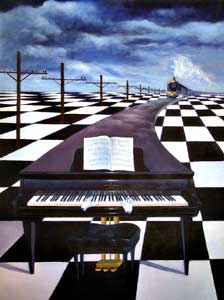
According to Wikipedia, Salvador Dali's work "Spellbound" was created in 1945 as part of a series of scenes in Alfred Hitchcock's thriller of the same name. Dali, known for being a Surrealist, was hired by Hitchcock to create the dream sequence, in which actor Gregory Peck, in an attempt to cure his mental illness, relates a strange and disjointed dream to his psychiatrists. (You can view the cached version of this clip by clicking
here.)
Dali was the perfect person to design the sequence as he was a Surrealist. In other words, his work was created by using the paranoiac-critical method--a technique devloped by Dali in the 1930's that acknowledged the ability of the brain to "perceive links between things which are rationally not linked" (Wikipedia), which is exactly what happens in dreams.
Details from the work really reveal that Dali is attempting to enter a person's subconscious to create the effect of our helter skelter dreams. Objects and people from both reality and imagination are juxtaposed against one another. Above the stage are curtains painted with giant eyes. They are fantastical. Some of the eyes are open, some closed, many looking in different directions. One wonders while viewing this work if the top is painted and the bottom is a real photo. It is possible that these painted eyes represent the eyes of the men at the tables below--and the varying reactions they are having to the woman who appears to be on stage, dancing. The legs of the tables appear to be human legs, and one of the eyes appears to have a symbol engraved in it. This symbol could be a key, plane, spade, bird, or airplane. The action taking place on the dance floor seems to be blending into a film that is going on against the backdrop. In fact, the different areas of the painting--the film, the drapes, the men--all seem to intersect at the figure of the woman, who is located slightly right of center. The intersection of all of these real and fictional worlds begs the questions--what is genuinely, authentically real? Can reality be defined? Can one create alternate realities using the imagination? So many eyes create the atmosphere, again, of paranoia, as if one is constantly being watched.
This mixing of fantasy elements with reality raises many questions. Is Dali making a statement about the nature of reality? He is quoted as saying that his most famous painting,
The Persistence of Time, was created to "systemize confusion and thus discredit completely the world of reality", according to the Museum of Modern Art website (MOMA). This quote, coupled with knowledge of Dali's eccentric antics, such as showing up at a ball held in his honor wearing a glass cage on his heart that contained a brasseire (bra), indicates to me that he was in favor of the imagination over reality. I think the archetype of the eye--which could represent insight or seeing beyond what's just literally in front of you--is present in his painting, too. Dali asks you not to trust what you see--to actually let yourself give in to reading between the lines, to risk paranoia. Also, the fact that this is part of a dream sequence relies on the archetype of sleep, which, according to our hand out on archetypes, is crucial for psychological healing. During dreams, a person can grow, discover more about his or her inner workings, fantasize and awaken with a greater understanding of human nature. In the movie, sleep as a healing time definitely aligns with what happens. Gregory Peck ends up uncovering a repressed childhood trauma through his dream and resolves his inner conflicts.
However, Dali's work still makes me, as a viewer, ask myself some questions about reality and imagination that perhaps Dali didn't intend. Are we, in America, all rather delusional at this point, believing our own press and our own narcisstic, self-created personas on Facebook and blogs? Do we need stricter boundaries between what is real and fantasy, so more people can tell the difference?
Questions: watch the full dream sequence. What do you think slicing the eye means, using archetypes to interpret the meaning? How do you, personally, feel about Americans and their tendency to live in worlds of fantasy--from video games to movies to reinventing themselves on line and in real life?








